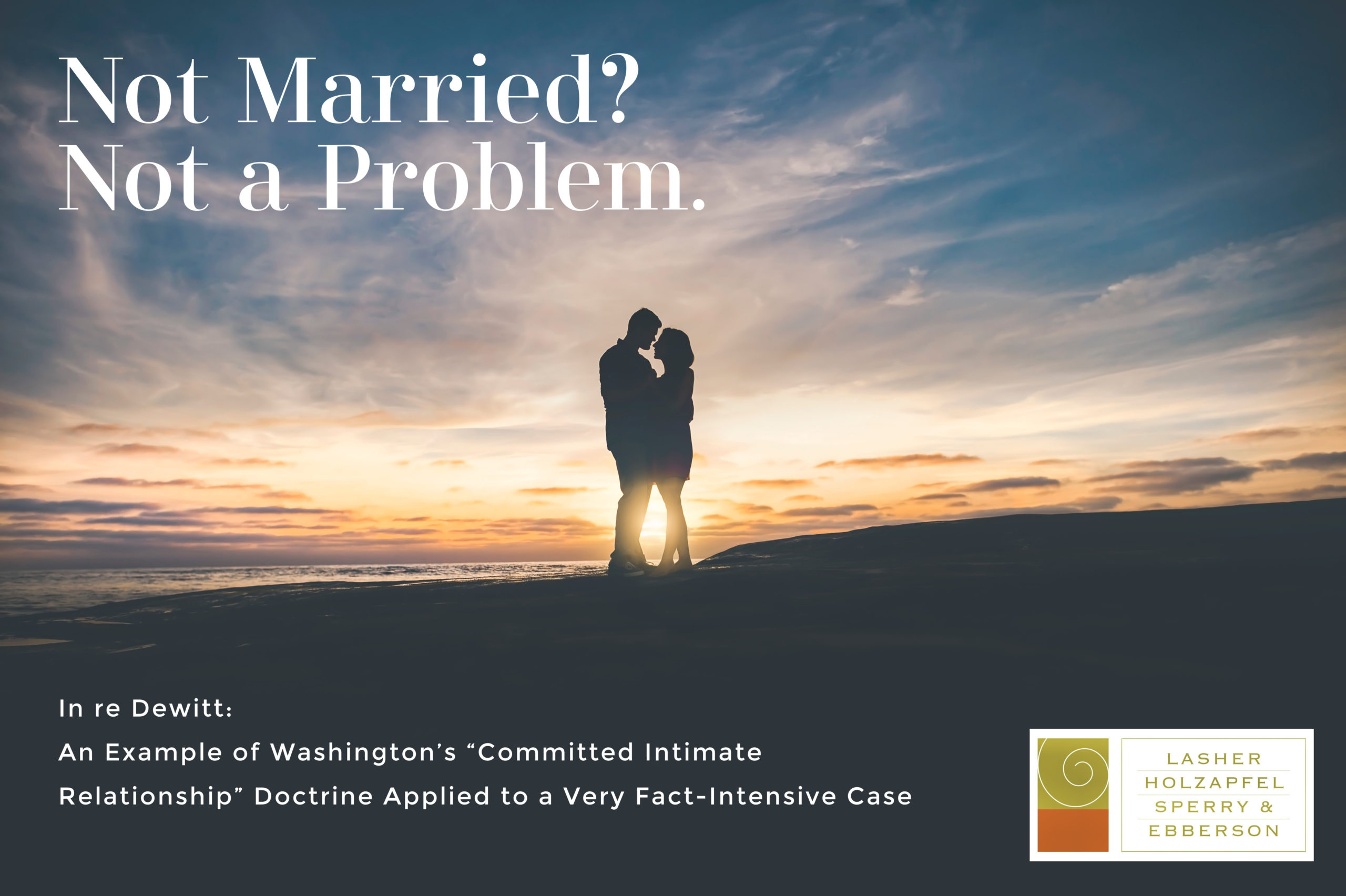In re Dewitt: An Example of Washington’s “Committed Intimate Relationship” Doctrine Applied to a Very Fact-Intensive Case

Posted on June 9, 2022 by Will Reingold
In a prior blogpost, I discussed Washington State’s Committed Intimate Relationship Doctrine (“CIR”) and outlined the five non-exclusive factors courts consider in determining whether a CIR existed: (1) continuity of cohabitation, (2) duration of relationship, (3) purpose of the relationship, (4) pooling of resources, and (5) intent of the parties. These factors (known as the Connell factors) are weighed by the judge to determine if there is a CIR. You can read about that here. This blogpost is meant to delve into an application of the CIR doctrine, as compared to my first blogpost that provided a more general overview.
Typically, where one party asserts that a CIR existed, the other party will vehemently deny it: for example, if Party X says that the relationship lasted for 10 years, Party Y may assert that they broke up and got back together; if Party X says they intended to be a family, Party Y may assert that they merely had a transactional relationship and that they dated other people. It should come as little surprise how different two people’s stories can be when they recount their relationship (or lack thereof) when a CIR claim is made. This is exemplified by In re Dewitt,[1] where Leonard Dewitt and Kevin Hannan gave sharply contrasting stories about their relationship.
Because the facts of In re Dewitt are quite lengthy and detailed, only a broad overview will be accounted for here. Leonard and Kevin met in 2002, and they had some type of relationship until around 2018. Leonard wanted to show that there was a CIR, whereas Kevin asserted that over the years they were “occasionally . . . sexually intimate,” that they never lived together, that their relationship was “a fundamentally casual one” in which they would see each other a few times per year, and that Leonard was actually in a CIR with his close friend he lived with from 2005 to 2016. Although Kevin admitted to giving Leonard “a key to his house and access to his debit cards and checkbook in April 2018,” this was only to assist Kevin with contractors working on the home, and “[h]e submitted identity theft, theft, and fraud complaints to the Tacoma Police Department and Federal Trade Commission” when he noticed a number of unauthorized purchases and cash advances.
Leonard refuted Kevin’s characterization of their relationship. He asserted they had been living together since 2016, and prior to that they lived with one another sporadically “due to the dynamics of [their] relationship” and because “Kevin needed space.” Leonard stated they were continuous partners during this time and financially supported one another. According to Leonard, “[t]he change in laws about gay marriage” played a role in their decision to be together permanently. He also said he and Kevin had a traditional family dynamic where one was the breadwinner and one was the homemaker: they watched television, laughed, comforted each other, went shopping, went out to eat, were attentive and supportive of one another, and “did all the normal things that a married couple does.” He also noted that he never paid rent to live with Kevin and denied that his level of intimacy with his friend ever rose to the level that he and Kevin shared.
Upon hearing arguments, the trial court walked through the CIR factors and concluded that there was no CIR in this case. The Court of Appeals affirmed the decision, concluding that three of the five CIR factors weighed against the existence a CIR: continuous cohabitation, the pooling of resources, and intent of the parties. One important takeaway from In re Dewitt is to have plenty of documentation to back up your claims. Kevin had plenty of documentary evidence to show that he and Leonard lacked a continuous relationship, pooled resources, and did not intend to hold themselves out as a couple; and as the Court observed: “[a]rguably, these are the three most important factors.”[2]
If you are Washington resident and think there is a CIR component to your case, an attorney can help walk you through the specifics of how to either establish a CIR or deny one’s existence. Text messages, bank statements from joint accounts, and other forms of evidence can strengthen your case, and an attorney at Lasher Holzapfel Sperry & Ebberson can help you organize and set out your case.
[1] In re Dewitt, No. 53794-o-II, 2021 WL 982588 (Wash. Ct. App. Mar. 16, 2021). The case is unpublished, but can be cited as persuasive (i.e., nonbinding, instructive) authority under Wash. G.R. 14.1(a). A copy of the case can be found here: https://casetext.com/case/in-re-committed-intimate-relationship-of-dewitt
[2] This should constitute dicta, and I would contend conflicts with the Washington Supreme Court’s statement that “[o]ne Connell factor is not more important than another.” In re Marriage of Pennington, 14 P.3d 764, 772 (Wash. 2000) (en banc).

